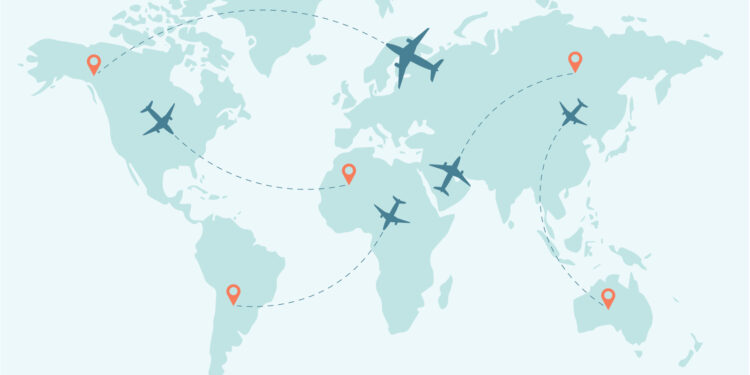Reclear Flight Planning for Business Aviation 101

Reclear is a technique used in planning and managing fuel reserves – on long-haul flight legs – in such a way that these reserves can be deployed more effectively. Reclear flight planning has the advantage of providing additional flexibility – giving operators the ability to fly longer routes, increase payloads, or fly at higher cruise speeds. While reclear flight planning is more common in the commercial airline word, it has benefits that should not be overlooked for business aircraft operators – especially when flying longer-haul legs with larger aircraft.
The following is an overview of what you need to know:
1. Understand the reclear process
Reclear flight planning was originally designed for the airlines in cases where long-distance flights were faced with landing with less than legal fuel reserves. Using the later stages of a flight, the crew picks a reclear airport near their destination where the aircraft can land if needed. They then reclear at a fix near that airport and recalculate fuel reserves from that point to the original destination. This technique can be used to achieve additional range. It’s particularly advantageous for larger, General Aviation (GA) aircraft – including ACJs and BBJs – but also well suited to operators of ultra-long range equipment, including Bombardier Global series or Gulfstream G550s/G650s.
2. Know the potential advantages
When using reclear flight planning, there’s the potential to fly longer legs and/or legs at higher cruise speeds. A flight from Los Angeles (KLAX) to Hong Kong (VHHH), for example, may require flying at long-range cruise. But, with a reclear, you may be able to fly the leg at a more efficient, faster, cruise speed and reduce crew duty day. At the reclear airport, you compare fuel estimated to be burned against fuel actually burned. At this point, the crew can divert to a suitable, recleared airport if there’s not enough fuel to get to the destination. When calculating a waypoint, you do not have to include climb – as you do on a regular flight plan – so you’re able to shift more of your fuel reserves into burnable fuel. Fuel designated as contingency fuel – which may now be much less than originally estimated – can be recalculated as fuel that can be burned. Potential advantages of reclearing include avoiding a tech stop and additional landing permits, increasing cruise speed to get passengers to destination, and reducing crew duty day.
3. Take advantage of fuel reserves – legally
Without a reclear, you’ll carry fuel from origin to destination, plus 10% en-route fuel reserves, 30 minutes of hold, and fuel reserves to an alternate. Of this, only the 10% reserve offers any possibility of reduction by way of a reclear – should you decide to divert from the reclear waypoint. You may also achieve savings by not carrying as much additional fuel, and this translates into more payload.
4. Reclear is part of the flight plan
You file one flight plan to your destination, but a reclear and reclear waypoint are part of this flight plan. The crew does not have to update air traffic control unless there’s a diversion. When you reclear, you want to be as close as possible to Top of Descent (TOD). In some cases – such as Honolulu (PHNL) to Sydney (YSSY) – your reclear will be sooner than TOD (more likely New Caledonia [NWWW]) as there’s nothing between that point and your destination. Aircraft dispatchers typically do reclears for scheduled commercial airlines while flight crew – in most cases – do this in the case of GA.
5. Know the steps when filing a flight plan
On your filed flight plan, one section will have original fuel burns and contingencies, while another section will have reclear information and a new fuel contingency. You want to ensure that the reclear airport is along your route and that it’s suitable. It’s important, also, to have appropriate landing permits for the reclear airport. If extended twin overwater operations are required, ensure that you have the correct amount of fuel and reserves. There are also regulations regarding reclearing that must be adhered to depending on your country of aircraft registration.
6. Benefits vary based on size of aircraft
The reclear procedure is more effective for larger aircraft. Typically, 10% of trip fuel is for reserves, and this has a more significant impact with larger aircraft. Optimum position for the reclear waypoint is approximately 92% of the distance from origin to destination.
7. Learn more about reclear flight planning
Talk with your 3rd-party provider regarding proper flight plan formatting. Be sure to inform them what you’d like to do for specific flight legs. Most operators use the reclear technique for frequently flown legs and are familiar with these routings and requirements. As this procedure pertains to fuel, and fuel reserves, there needs to be a comfort level, and it’s best if the route/city pair is one you’ve operated before. There can be issues if airspace is busy and the aircraft is held up too long in traffic. In this case, crew will have to make a decision at the reclear waypoint.
Conclusion
Reclear flight planning has particular benefits for long-haul operators of larger aircraft. By using this technique, you may legally be able to complete a leg that’s longer than would otherwise be possible without a reclear – based on traditional origin-to-destination fuel reserve requirements. You may also be able to fly longer legs faster – getting passengers to destination earlier and staying within crew duty day limitations.
Questions?
If you have any questions about this article or flight planning in general, contact us at markmiller@univ-wea.com or markchristensen@univ-wea.com.



